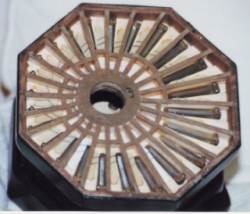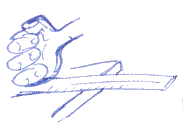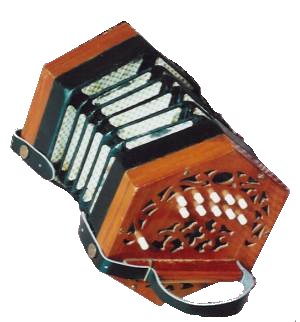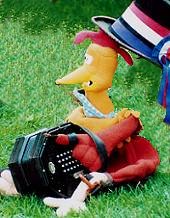 Return To Home Page
Return To Home Page
 Back to Table Of Contents
Back to Table Of Contents
 Return To Home Page Return To Home Page
|
 Back to Table Of Contents Back to Table Of Contents
|
| The concertina makes its noise in the same way that a ruler does when it's being twanged over the side of a desk. Here the ruler is very small, between about 2 cm. and less than 1 cm., depending on whether it's producing a low or a high note. It is fastened into a metal plate, with a hole just the right size and shape for the reed to move in: |

|
| A concertina reed, all by itself, in its metal plate. You can't see much of the hole because the reed is just about the same size! | |

|
At each end of the concertina the reeds are arranged rather as if they are in between the spokes of a wheel, fastened to a flat layer of wood. This is called the reed pan, and that's what this picture shows. In the gaps in between the spokes are the reeds, each one in its reed plate, each plate slid into a slot in the piece of wood holding them, and each reed has its own separate tiny room-like box to work in. |

|
The concertina has various layers fastened together - each end is a bit like a multi-layered burger... though not so easy to chew. (Hint - don't ever try. It seriously annoys concertina players, and would probably give you a nasty case of splinters and broken teeth.) This time the reed pan is lying next to the layer with the air holes covered with leather pads. When you press the buttons, the pads open up... |

|
... and the reed vibrates in the air stream, which can now blow in from the bellows, rather like that ruler over the side of the desk.
(I could get really tired of that ruler bouncing away here...) |

|
and each has its plate, with two bolts, and leather valves, and all the rest... there are more than 1,000 bits to fit in. That makes the whole thing quite expensive. |
 This is part of an advertisement from The Times newspaper for Thursday, February 23rd, 1872. If you'd like to see the whole advert, click on this one. You can click on that picture to get back here.
This is part of an advertisement from The Times newspaper for Thursday, February 23rd, 1872. If you'd like to see the whole advert, click on this one. You can click on that picture to get back here.
|
... the "German pattern concertina."
This has only 20 buttons, and each one plays a different note when you're squeezing from when you're pulling out on the bellows. It's quite confusing at first, but useful when you get used to it. It can't play such complicated tunes, of course, but it can manage simpler ones very well. And it's cheaper. More to come later... |

|

|
Meanwhile, here's a picture to go on with. You really get all sorts playing concertinas these days. |
 Return To Home Page Return To Home Page
|
 Return to top of this page. Return to top of this page.
|